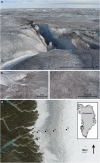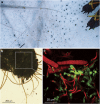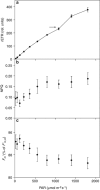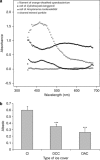Photophysiology and albedo-changing potential of the ice algal community on the surface of the Greenland ice sheet
- PMID: 23018772
- PMCID: PMC3504962
- DOI: 10.1038/ismej.2012.107
Photophysiology and albedo-changing potential of the ice algal community on the surface of the Greenland ice sheet
Abstract
Darkening of parts of the Greenland ice sheet surface during the summer months leads to reduced albedo and increased melting. Here we show that heavily pigmented, actively photosynthesising microalgae and cyanobacteria are present on the bare ice. We demonstrate the widespread abundance of green algae in the Zygnematophyceae on the ice sheet surface in Southwest Greenland. Photophysiological measurements (variable chlorophyll fluorescence) indicate that the ice algae likely use screening mechanisms to downregulate photosynthesis when exposed to high intensities of visible and ultraviolet radiation, rather than non-photochemical quenching or cell movement. Using imaging microspectrophotometry, we demonstrate that intact cells and filaments absorb light with characteristic spectral profiles across ultraviolet and visible wavelengths, whereas inorganic dust particles typical for these areas display little absorption. Our results indicate that the phototrophic community growing directly on the bare ice, through their photophysiology, most likely have an important role in changing albedo, and subsequently may impact melt rates on the ice sheet.
Figures






References
-
- Anesio AM, Hodson AJ, Fritz A, Psenner R, Sattler B. High microbial activity on glaciers: importance to the global carbon cycle. Glob Change Biol. 2009;15:955–960.
-
- Anesio AM, Sattler B, Foreman C, Telling J, Hodson A, Tranter M, et al. Carbon fluxes through bacterial communities on glacier surfaces. Annal Glaciol. 2010;51:32–40.
-
- Barranguet C, Beusekom SAM, Veuger B, Neu TR, Manders EMM, Sinke JJ, et al. Studying undisturbed autotrophic biofilms, still a technical challenge. Aquat Microb Ecol. 2004;34:1–9.
-
- Berggren S. Alger frän Grönlands inlandis. Kongl Vetensk-Akad Förhandl. 1871;28:293–296.
-
- Bøggild CE, Brandt RE, Brown KJ, Warren SG. The ablation zone in northeast Greenland: ice types, albedos and impurities. J Glaciol. 2010;56:101–113.

